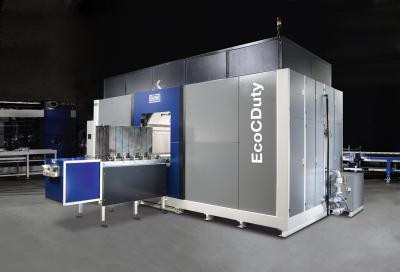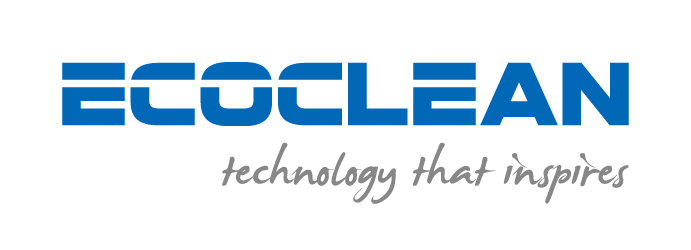
Heat-treating contractors, metalforming shops and companies from the automotive and aircraft industries in particular require cost-efficient part cleaning and degreasing equipment capable of handling high capacities. Addressing this demand, Dürr Ecoclean has developed an innovative solvent-based cleaning system, the large-chamber EcoCDuty. This machine is designed for loads measuring up to 1250mm x 840mm x 970mm and weighing up to 1 ton. Operating with hydrocarbons or modified alcohols, it provides high cleaning quality and process reliability at fast cycle times. Additional benefits of this modular unit include its exceptional ease of operation and attractive design.
Heat-treating shops must clean workpieces in large quantities, both before heating and after quenching in oil. With punched and shaped parts leaving the press at just a few second intervals, the part cleaning process must not slow down production. In the automotive industry, suspension components and other aluminium and steel items must have a (laser-)weldable surface. In aircraft manufacturing, honeycomb parts, shaped components and pipes impose high demands on the equipment due to their dimensions and specified cleaning results. Although products differ, the demands on the cleaning system are the same. It must provide enhanced capacity, process reliability, cost and energy efficiency, and speed. Over and above these properties, high availability, ease of maintenance, eco-friendliness, favourable investment costs and short delivery times are important. In developing the new EcoCDuty engineers therefore focused on these criteria.
This large-chamber cleaning machine built by Dürr Ecoclean uses hydrocarbons or polar solvents (modified alcohols) and operates under full vacuum. Its modular design ensures adaptability to individual user needs. Configured as a steam degreaser in its standard version, the system is additionally available with one or two stainless steel flood tanks – e.g., for a process comprising steam degreasing and injection flood washing or steam degreasing, injection flood washing plus a preserving step. Vacuum drying is standard on all three versions. Chlorinated metalworking fluids can be effectively removed by means of appropriately stabilized solvents following oil compatibility testing. Moreover, the unit is perfectly suitable for cleaning off sulphur-containing oils.
To ensure a high cleaning quality, the EcoCDuty is provided with a new pre-degreasing feature using steam. This innovative technology directs the oil-laden solvent straight into the distillation circuit, thus minimizing oil enrichment of the solvent and oil deposits in the flood tank for superior cleaning performance. This is made possible by a powerful distillation system capable of handling as much as 400 or even 500 litres/hour, depending on the solvent employed. The oil collected by distillation is automatically removed via the standard oil discharge system which has a capacity of four litres per hour. Customers who encounter high oil input rates can add a second unit, thus doubling the capacity of the distillation system to eight litres per hour. To remove particulate contaminants from the solvent as well, the distillation system is preceded by a filter unit with bag or cartridge filters. This system further contributes to the good cleaning result and prolongs the service life of the solvent.
On EcoCDuty versions with a flood tank, quick flooding and draining of the work chamber and tank is ensured by powerful frequency-controlled pumps. This technology reduces non-productive times and speeds up cleaning processes, thereby reducing costs. Furthermore, these versions comprise a separate filter circuit for each tank. Full-flow filtration of the solvent is provided in the supply and return flow lines by means of three filter units per flood tank. These can be fitted with bag or cartridge filters. As a result, even exceptional cleanliness specifications can be reliably met.
When designing the EcoCDuty, Dürr Ecoclean placed great emphasis on low operating costs and high availability. This starts with the new 7" colour display with self-explanatory pictographs that makes the cleaning system simple, safe and quick to operate. The stainless steel flood tanks have a smooth surface and come without internal heating components. This design prevents the formation of chip and dirt pockets which could re-contaminate the parts. Customers who do not yet own a steam heating source can order an optional external steam generator to heat the distillation unit. The flood tanks are heated exclusively by waste heat from the distillation system, i.e., no additional energy input is necessary.
When it comes to part feeding, the EcoCDuty again adapts flexibly to customer needs. Depending on the equipment configuration, it can be loaded manually using a pallet truck or forklift. Moreover, custom loading solutions ranging from semi-automatic single-station to fully automatic multi-station systems are supported as well.
Large maintenance openings offer an additional advantage, as they provide very easy and fast access to all service-related components. This minimizes system downtime for maintenance work.
To protect the system from dirt and heat in harsh production conditions, a roof with internal ventilation is available—designed to match the machine's attractive design.
Contact Details
Related Glossary Terms
- heat-treating
heat-treating
Process that combines controlled heating and cooling of metals or alloys in their solid state to derive desired properties. Heat-treatment can be applied to a variety of commercially used metals, including iron, steel, aluminum and copper.
- metalforming
metalforming
Manufacturing processes in which products are given new shapes either by casting or by some form of mechanical deformation, such as forging, stamping, bending and spinning. Some processes, such as stamping, may use dies or tools with cutting edges to cut as well as form parts.
- metalworking
metalworking
Any manufacturing process in which metal is processed or machined such that the workpiece is given a new shape. Broadly defined, the term includes processes such as design and layout, heat-treating, material handling and inspection.
- modular design ( modular construction)
modular design ( modular construction)
Manufacturing of a product in subassemblies that permits fast and simple replacement of defective assemblies and tailoring of the product for different purposes. See interchangeable parts.
- quenching
quenching
Rapid cooling of the workpiece with an air, gas, liquid or solid medium. When applicable, more specific terms should be used to identify the quenching medium, the process and the cooling rate.

